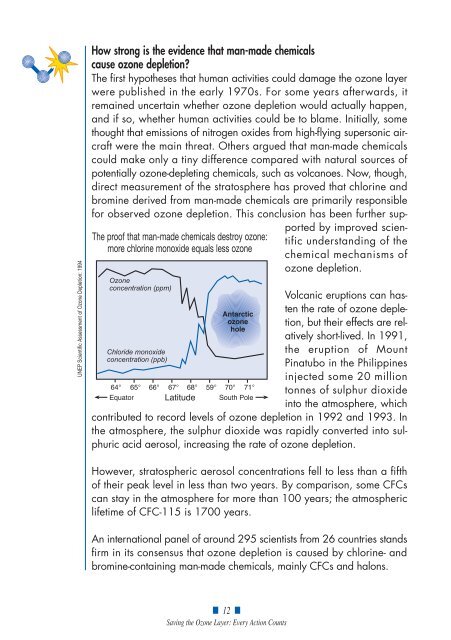Saving the Ozone Layer: Every Action Counts
Saving the Ozone Layer: Every Action Counts
Saving the Ozone Layer: Every Action Counts
You also want an ePaper? Increase the reach of your titles
YUMPU automatically turns print PDFs into web optimized ePapers that Google loves.
UNEP Scientific Assessment of <strong>Ozone</strong> Depletion: 1994<br />
The proof that man-made chemicals destroy ozone:<br />
more chlorine monoxide equals less ozone<br />
<strong>Ozone</strong><br />
concentration (ppm)<br />
Chloride monoxide<br />
concentration (ppb)<br />
Antarctic<br />
ozone<br />
hole<br />
64° 65° 66° 67° 68° 59° 70° 71°<br />
Equator Latitude South Pole<br />
How strong is <strong>the</strong> evidence that man-made chemicals<br />
cause ozone depletion?<br />
The first hypo<strong>the</strong>ses that human activities could damage <strong>the</strong> ozone layer<br />
were published in <strong>the</strong> early 1970s. For some years afterwards, it<br />
remained uncertain whe<strong>the</strong>r ozone depletion would actually happen,<br />
and if so, whe<strong>the</strong>r human activities could be to blame. Initially, some<br />
thought that emissions of nitrogen oxides from high-flying supersonic aircraft<br />
were <strong>the</strong> main threat. O<strong>the</strong>rs argued that man-made chemicals<br />
could make only a tiny difference compared with natural sources of<br />
potentially ozone-depleting chemicals, such as volcanoes. Now, though,<br />
direct measurement of <strong>the</strong> stratosphere has proved that chlorine and<br />
bromine derived from man-made chemicals are primarily responsible<br />
for observed ozone depletion. This conclusion has been fur<strong>the</strong>r supported<br />
by improved scientific<br />
understanding of <strong>the</strong><br />
chemical mechanisms of<br />
ozone depletion.<br />
Volcanic eruptions can hasten<br />
<strong>the</strong> rate of ozone depletion,<br />
but <strong>the</strong>ir effects are relatively<br />
short-lived. In 1991,<br />
<strong>the</strong> eruption of Mount<br />
Pinatubo in <strong>the</strong> Philippines<br />
injected some 20 million<br />
tonnes of sulphur dioxide<br />
into <strong>the</strong> atmosphere, which<br />
contributed to record levels of ozone depletion in 1992 and 1993. In<br />
<strong>the</strong> atmosphere, <strong>the</strong> sulphur dioxide was rapidly converted into sulphuric<br />
acid aerosol, increasing <strong>the</strong> rate of ozone depletion.<br />
However, stratospheric aerosol concentrations fell to less than a fifth<br />
of <strong>the</strong>ir peak level in less than two years. By comparison, some CFCs<br />
can stay in <strong>the</strong> atmosphere for more than 100 years; <strong>the</strong> atmospheric<br />
lifetime of CFC-115 is 1700 years.<br />
An international panel of around 295 scientists from 26 countries stands<br />
firm in its consensus that ozone depletion is caused by chlorine- and<br />
bromine-containing man-made chemicals, mainly CFCs and halons.<br />
■ 12 ■<br />
<strong>Saving</strong> <strong>the</strong> <strong>Ozone</strong> <strong>Layer</strong>: <strong>Every</strong> <strong>Action</strong> <strong>Counts</strong>
















